#Rapid Antigen test
Text
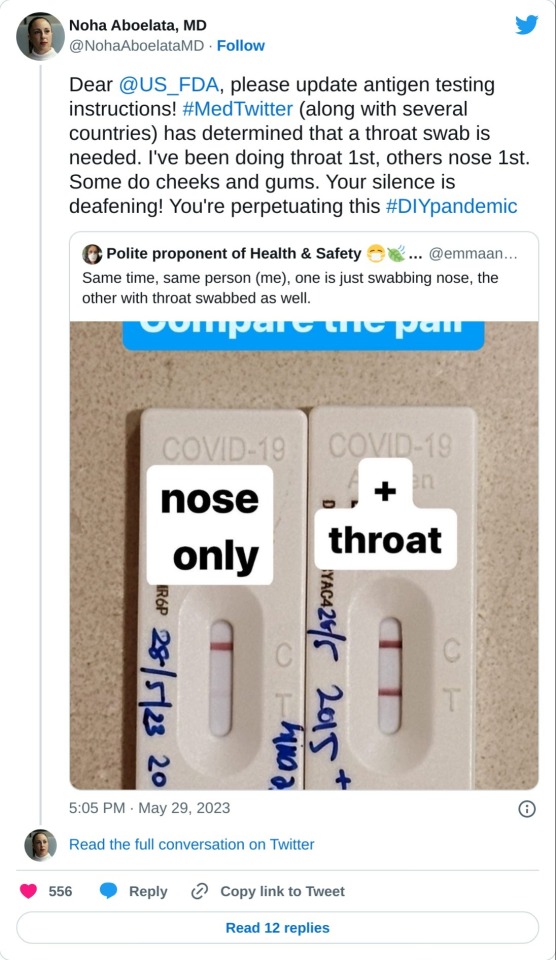




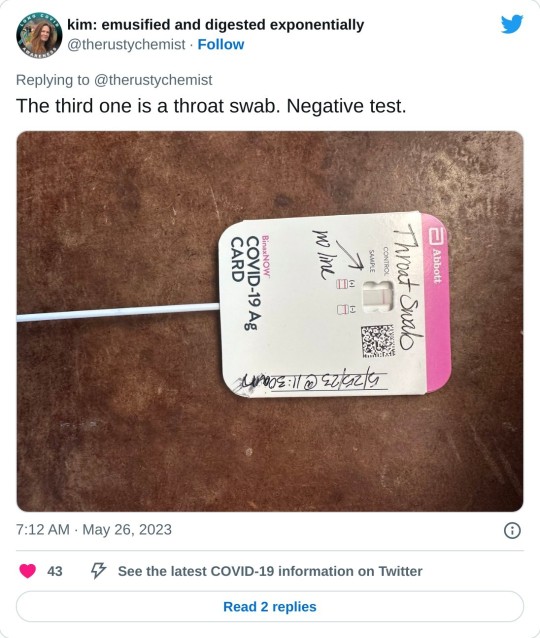
New methods for testing need to be standardized, well communicated and disseminated. These posts describe testing approaches that are experimental and still, may be of interest and or benefit so I decided to share.
*Note: Please continue to test. And try to request PCR if possible. Getting a record of your illness will be important for your health records and contact tracing. If you experience disability as a result of your infection. Covid is still here, and to the best of our ability we must try to record, notify, trace, research, treat and find treatments, and prevent it's spread. The importance of this has not waned and neither has the virus.*
Be thoughtful, wise, responsible and protect your health and others.
#Rapid Antigen Test#Rapid Antigen Tests#Testing#RATs#Covid Testing#Noha Aboelata MD#Emma Andollie#Covid-19#Covid 19#SARs CoV-2#Covid#The Pandemic#Pandemic#Public Health
30 notes
·
View notes
Text
Evolving peak SARS-CoV-2 loads relative to symptom onset may influence home-test timing | CIDRAP
Median SARS-CoV-2 viral loads, as measured by polymerase chain reaction cycle threshold (Ct) and antigen concentrations, rose from symptom onset, peaking on the fourth or fifth day of symptoms. Estimated rapid antigen test sensitivity was 30.0% to 60.0% on the first day, 59.2% to 74.8% on the third, and 80.0% to 93.3% on the fourth.
Plain English:
Highest viral load is ~4-5 days into symptom onset, which means you're most likely to test positive about a week after an initial infection.
That also means that if you're IC/HR/etc. (or healthy & just don't want a disease that has a high chance of turning into long-term disability) and need to isolate from someone who's likely been exposed, the "quarantine" period should be at least 4-5 days, if not up to a week.
This has been the case for several years, not new, and corroborated by virologists and epidemiologists I've spoken to about their own protocol for infection avoidance.
#covid#article#research#cidrap#quarantine#viral load#peak viral load#masking#avoiding covid#sars cov 2#rapid antigen test#rapid tests#RAT
6 notes
·
View notes
Text
The thing about rapid antigen tests is like, a negative result is so wild because what if the person just didnt do it properly at home and didnt even swab the right places???? Is it really a negative or was it just a Bad At Home Test
2 notes
·
View notes
Text

Update SARS-CoV-2 Omicron variant JN.1 Immunity, Transmissibility and Vaccines, Diagnostic Capacity and Therapeutics as of March 26, 2024
#CDC #COVID19 #SARSCoV2 #Omicron #JN1 #JN1Variant #RapidAntigenTest #RTPCR #Paxlovid
https://www.idsociety.org/covid-19-real-time-learning-network/diagnostics/covid-19-variant-update/#/+/0/publishedDate_na_dt/desc/
0 notes
Text
gonna take a rapid antigen test
(hilarious to me that their acronym is rat im going to take a rat)
0 notes
Text
Trends in incidence of COVID 19 based on performed Rapid Antigen Test by Piratheepkumar. R in Journal of Clinical Case Reports Medical Images and Health Sciences
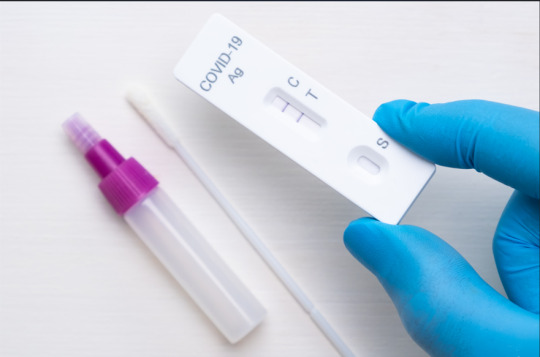
ABSTRACT
The COVID 19 outbreak represents a historically unprecedented pandemic, particularly dangerous and potentially lethal for elderly population. The biological differences in the immune systems between men and women exist which may impact our ability to fight an infection including SARS-2-CoV-2. Men tended to develop more symptomatic and serious disease than women, according to the clinical classification of severity. Age-related changes in the immune system are also different between sexes and there is a marked association between morbidity/mortality and advanced age in COVID-19. This is a single-center, retrospective, data oriented study performed at the private hospital, in Central Province, Sri Lanka. The data of the patients who performed the Rapid Antigen Test (RAT) to know whether they have infected by SARS-CoV-2 or not, were taken for analysis. Test performed date, age, sex, number of positive and negative cases, number of male and female patients were extracted. Finally the data were analyzed in simple statistical method according to the objective of the study. Totally 642 patients performed RAT within the period of one month from 11.08.2021 to 11.09.2021. Among them 426 (66.35%) are male and 216 (33.64%) are female. 20.4% (n=131) of male obtained positive result among the total male population (n=426). Likewise 11.4% (n=73) of female obtained positive result among the total male population (n=216). Large number of positive cases was observed (34.89%) between the age group of 31-40 years in both sexes. The age group of 21-30 and 41-50 years also were shared the almost same percentage (17.13% & 17.75). The large number of positive male patients observed among the age group of 41-50 years. Almost same number of patients was observed in the age group of 21-30 and 31-40. The least number of positive cases (0.7% and 0.9%) observed almost in 0-10 and 81-90 years. When considering the females, large number of positive female patients observed among the age group of 31-40 years.
Key words: Rapid Antigen Test, Covid-19, SARS-CoV-2
INTRODUCTION
A rapid antigen test (RAT) or rapid antigen detection test (RADT), is a rapid diagnostic test suitable for point-of-care testing that directly detects the presence of an antigen. It is used to detect SARS-CoV-2 that cause COVID-19. This test is one of the type of lateral flow tests that detect protein, differentiate it from other medical tests such as antibody tests or nucleic acid tests, of either laboratory or point-of-care types. Generally 5 to 30 minutes only will take to get result and, require minimal training or infrastructure, and cost effective (1).
Sri Lanka was extremely vulnerable to the spread of COVID-19 because of its thriving tourism industry and large expatriate population. Sri Lanka almost managed two waves of Covid-19 pandemic well, but has been facing difficulties to control the third wave. The Sri Lankan government has executed stern actions to control the disease including island-wide travel restrictions. The government has been working with its development partners to take necessary action to mobilize resources to respond to the health and economic challenges posed by the pandemic (2) (3).
The COVID 19 outbreak is dangerous and fatal for elderly population. Since the beginning of the actual SARS-CoV-2 outbreak there were an evident that older people were at higher risk to get the infection and develop a more severe with bad prognosis. The mean age of patients that died was 80 years. The majority of those who are infected, that have a self-limiting infection and do recover are younger. On the other hand, those who suffer with more severe disease require intensive care unit admission and finally pass away are older (4).
Sandoval. M., et al mentioned that the number of patients who are affected by SARS-CoV-2 with more than 80 years of age is similar to that with 65–79 years. The mortality rate in very elderly was 37.5% and this percentage was significantly higher compared to that observed in elderly. Further their findings were suggested that the age is a fundamental risk factor for mortality (5).
Since February 2020, more than 27.7 million people in US have been diagnosed with Covid-19 (6). Rates of COVID-19 deaths have increased across the Southern US, among the Hispanic population, and among adults aged 25–44 years (7). Young adults are at increased risk of SARS-CoV-2 because of exposure in work, academic, and social settings. According to the several database of different health organizations young adult, aged 18-29, were confirmed Coid-19 (9).
Go to:Amid of coronavirus disease 2019 (Covid-19) pandemic, much emphasis was initially placed on the elderly or those who have preexisting health conditions such as obesity, hypertension, and diabetes as being at high risk of contracting and/or dying of Covid-19. But it is now becoming clear that being male is also a factor. The epidemiological findings reported across different parts of the world indicated higher morbidity and mortality in males than females. While it is still too early to determine why the gender gap is emerging, this article point to several possible factors such as higher expression of angiotensin-converting enzyme-2 (ACE 2; receptors for coronavirus) in male than female, sex-based immunological differences driven by sex hormone and X chromosome. Furthermore, a large part of this difference in number of deaths is caused by gender behavior (lifestyle), i.e., higher levels of smoking and drinking among men compared to women. Lastly, studies reported that women had more responsible attitude toward the Covid-19 pandemic than men. Irresponsible attitude among men reversibly affect their undertaking of preventive measures such as frequent handwashing, wearing of face mask, and stay at home orders.
The latest immunological study on the receptors for SARS-CoV-2 suggest that ACE2 receptors are responsible for SARS-CoV-2. According to the study by Lu and colleagues there are positive correlation of ACE2 expression and the infection of SARS-CoV (10). Based on the positive correlation between ACE 2 and coronavirus, different studies quantified the expression of ACE 2 proteins in human cells based on gender ethnicity and a study on the expression level and pattern of human ACE 2 using a single-cell RNA-sequencing analysis indicated that Asian males had higher expression of ACE 2 than female (11). Conversely, in establishing the expression of ACE 2 in the primary affected organ, a study conducted in Chinese population found that expression of ACE 2 in human lungs was extremely expressed in Asian male than female (12).
A study by Karnam and colleagues reveled that CD200-CD200R and sex are host factors that together determine the outcome of viral infection. Further a review on association between sex differences in immune responses stated that sex-based immunological differences contribute to variations in the susceptibility to infectious diseases and responses to vaccines in males and females (13). The concept of sex-based immunological differences driven by sex hormone and X chromosome has been well demonstrated via the animal study by Elgendy et al (14) (35). They were concluded the study that estrogen played big role in blocking some viral infection.
The biological differences in the immune systems between men and women may cause impact on fight for infection. Females are more resistant to infections than men and which mediated by certain factors including sex hormones. Further, women have more responsible attitude toward the Covid-19 pandemic than men such as frequent hand washing, wearing of face mask, and stay at home (15).
Most of the studies with Covid-19 patients indicate that males are mostly (more than 50%) affected than females (16) (17) (18). Although the deceased patients were significantly older than the patients who survived COVID-19, ages were comparable between males and females in both the deceased and the patients who survived (18).
A report in The Lancet and Global Health 5050 summary showed that sex-disaggregated data are essential to understanding the distribution of risk, infection and disease in the population, and the extent to which sex and gender affect clinical outcomes (19). The degree of outbreaks which affect men and women in different ways is an important to design the effective equitable policies and interventions (20). A systematic review and meta-analysis conducted to assess the sex difference in acquiring COVID-19 with 57 studies that revealed that the pooled prevalence of COVID-19 confirmed cases among men and women was 55% and 45% respectively (21). A study in Ontario, Canada showed that men were more likely to test positive (22) (23). In Pakistan 72% of COVID-19 cases were male (24). Moreover, the Global Health 5050 data showed that the number of COVID-19 confirmed cases and the death rate due to the disease are high among men in different countries. This might be because behavioral factors and roles which increase the risk of acquiring COVID-19 for men than women. (25) (26) (27).
Men mostly involved in several activities such as alcohol consumption, being involved in key activities during burial rites, and working in basic sectors and occupations that require them to continue being active, to work outside their homes and to interact with other people even during the containment phase. Therefore, men have increased level of exposure and high risk of getting COVID-19 (28) (29) (30).
Men tended to develop more symptomatic and serious disease than women, according to the clinical classification of severity (31). The same incidence also noticed during the previous coronavirus epidemics. Biological sex variation is said to be one of the reasons for the sex discrepancy in COVID-19 cases, severity and mortality (32) (33). Women are in general able to stand a strong immune response to infections and vaccinations (34).
The X chromosome is known to contain the largest number of immune-related genes in the whole genome. With their XX chromosome, women have a double copy of key immune genes compared with a single copy in XY in men. This showed that the reaction against infection would be contain both innate and adaptive immune response. Therefore the immune systems of females are generally more responsive than females and it indirectly reflects that women are able to challenge the coronavirus more effectively but this has not been proven (32).
Sex differences in the prevalence and outcomes of infectious diseases occur at all ages, with an overall higher burden of bacterial, viral, fungal and parasitic infections in human males (36) (37) (38) (39). The Hong Kong SARS-CoV-1 epidemic showed an age-adjusted relative mortality risk ratio of 1.62 (95% CI = 1.21, 2.16) for males (40). During the same outbreak in Singapore, male sex was associated with an odds ratio of 3.10 (95% CI = 1.64, 5.87; p ≤ 0.001) for ITU admission or death (41). The Saudi Arabian MERS outbreak in 2013 - 2014 exhibited a case fatality rate of 52% in men and 23% in women (42). Sex differences in both the innate and adaptive immune system have been previously reported and may account for the female advantage in COVID-19. Within the adaptive immune system, females have higher numbers of CD4+ T (43) (44) (45) (46) (47) (48) cells, more robust CD8+ T cell cytotoxic activity (49), and increased B cell production of immunoglobulin compared to males (43) (50). Female B cells also produce more antigen-specific IgG in response to TIV (51).
Age-related changes in the immune system are also different between sexes and there is a marked association between morbidity/mortality and advanced age in COVID-19 (52). For example, males show an age-related decline in B cells and a trend towards accelerated immune ageing. This may further contribute to the sex bias seen in COVID-19 (53).
Hence, this single center, retrospective, data oriented study performed to identify the gender age influences the RAT results and the rate of positive cases before and after the lockdown.
METHODOLOGY
This is a single-center, retrospective, data oriented study performed at the private hospital, Central Province, Sri Lanka. The data of the patients who performed the Rapid Antigen Test (RAT) from 11.08.2021to 11.0.2021 to know whether they have infected by SARS-CoV-2 or not, were taken for analysis. The authors developed a data extraction form on an Excel sheet and the following data from main data sheet. Test performed date, age, sex, number of positive and negative cases, number of female patients and number of male patients were extracted. Mistyping of data was resolved by crosschecking. Finally the data were analyzed in simple statistical method according to the objective of the study.
RESULTS AND DISCUSSION
Totally 642 patients performed RAT within the period of one month from 11.08.2021 to 11.09.2021. Among them 426 (66.35%) are male and 216 (33.64%) are female. Men mostly involved in several activities such as alcohol consumption, being involved in key activities during burial rites, and working in basic sectors and occupations that require them to continue being active, to work outside their homes and to interact with other people even during the containment phase. Therefore, men have increased level of exposure and high risk of getting COVID-19 (28) (29) (30). The present data descriptive study also were supported certain previous research findings.

Figure 1: RAT positive male cases among the total male patients performed RAT with days
Figure 1 shows that the number of male patients got positive result in RAT among the total male patients who performed RAT on every day. According to that, 20.4% (n=131) of male obtained positive result among the total male population (n=426). Philip Goulder, professor of immunology at the University of Oxford stated that women’s immune response to the virus is stronger since they have two X chromosomes which is important when talk about the immune response against SARS-Cov-2. Because the protein by which viruses such as coronavirus are detected is fixed on the X chromosome. This is exactly looks like females have double protection compare to male. The present study also showed that large number of RAT positive cases were observed in males compare to females. Gender based lifestyle would have been another possibility for large number of males got positive in RATs. There are important behavioral differences between the sexes according to certain previous research findings (54).
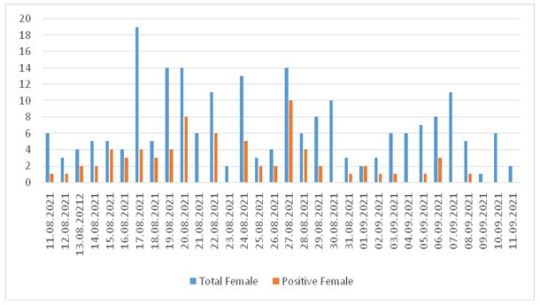
Figure 2: RAT positive female cases among the total female patients performed RA
Figure 2 shows that the number of female patients got positive result in RAT among the total female patients who performed RAT on every day. According to that, 11.4% (n=73) of female obtained positive result among the total male population (n=216).

Figure 3: The pattern of total RAT positive cases before and after lockdown.
Figure 3 showed that the relations between the number of positive cases before and after the lockdown. The lockdown declared by the tenth day from the initial day when the data was taken for analysis. The red vertical line differentiates the period as two such as before and after the lockdown. Though there was no decline observed as soon as immediately considerable decline was observed after the 21 days of onset of lockdown. Staying at home, avoiding physical contacts, and avoiding exposure in crowded areas are the best way to prevent the spread of Covid – 19 (54). However the significant decline would be able to see after three weeks only from the date of lockdown since the incubation period of SARS-CoV-2 is 14-21 days. The continuous study should be conducted in order to prove it. However the molecular mechanism of COVID-19 transmission pathway from human to human is still not resolved, the common transmission of respiratory diseases is droplet sprinkling. In this type of spreading, a sick person is exposed to this microbe to people around him by coughing or sneezing. Only the way to prevent these kind of respiratory diseases might be prevent the people to make close contact (54) (55). Approximately 214 countries reported the number of confirmed COVID-19 cases (56). Countries including Sri Lanka have taken very serious constraints such as announced vacation for schools, allowed the employers to work from home and etc. to slow down the COVID 19 outbreak. The lockdown days differ by countries. Countries have set the days when the lockdown started and ended according to the COVID-19 effect on their public. Some countries have extended the lockdown by many days due to COVID-19 continues its influence intensely on the public (57) (58).
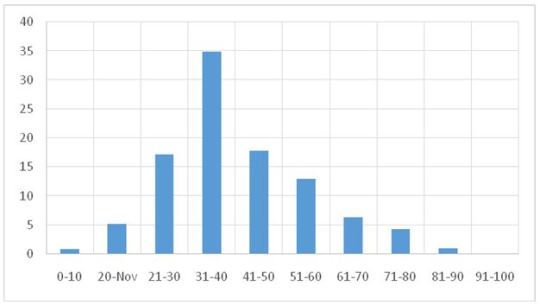
Figure 4: Incidence of COVI 19 by age group
Figure 4 showed that the incidence of Covid-19 and age group. Accordingly large number was observed (34.89%) between the age group of 31-40 years in both sexes. The age group of 21-30 and 41-50 years also were shared the almost same percentage (17.13% & 17.75). A study provides evidence that the growing COVID-19 epidemics in the US in 2020 have been driven by adults aged 20 to 49 and, in particular, adults aged 35 to 49, before and after school reopening (59). However many researches pointed out that adults over the age of 60 years are more susceptible to infection since their immune system gradually loses its resiliency.

Figure 5: The age group and RAT positive male cases among the total positive cases
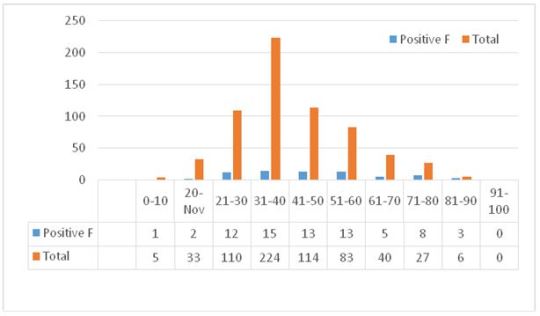
Figure 6: Age group and RAT positive female cases
Figure 5 & 6 showed that the relations between the positive number of male & female patients and the age group of total patients. According to that the large number of positive male patients observed among the age group of 41-50 years. Almost same number of patients was observed in the age group of 21-30 and 31-40. The least number of positive cases (0.7% and 0.9%) observed almost in 0-10 and 81-90 years. When considering the females, large number of positive female patients observed among the age group of 31-40 years. In USA Ministry of Health has reported 444 921 COVID-19 cases and 15 756 deaths as of August 31. For men, most reported cases were persons aged 30–39 years (22.7%), followed by 20–29 year-olds (20.1%) and 40–49 year-olds (17.1%). Most reported deaths were seniors, especially 70–79 year-olds (29.5%), followed by those aged 80 years and older (29.2%), and 60–69 year-olds (22.8%). Also found a similar pattern for women, except that most deaths were reported among women aged 80 years and older (44.4%) (60).

Figure 7: Age group and the positive cases
Table 1: Relations between the age group, sex, and RAT results
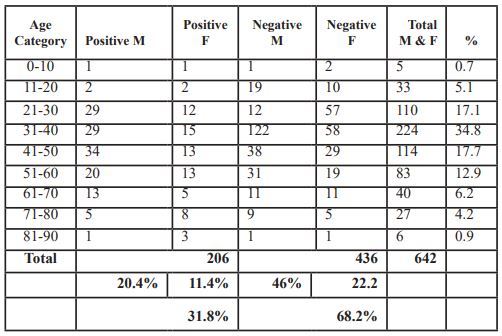
CONCLUSION
The present study showed that the male are mostly got positive in RAT test than female. Further comparing the old age young age group in both sexes were noticed as positive in RAT. Moreover there were no relationship observed before and after the lockdown and trend of Covid-19
The limitations of the study
This study has several limitations.
Only 1 hospital was studied.
More than the absence of specific data on mobility patterns or transportation, detail of recovery, detail of mortality etc.
The COVID-19 pandemic is still ongoing so statistical analysis should continue. There are conflicting statements regarding lockdown by countries on COVID-19.
The effect of the lockdown caused by the COVID-19 pandemic on human health may be the subject of future work
For more information: https://jmedcasereportsimages.org/about-us/
For more submission : https://jmedcasereportsimages.org/
#Rapid Antigen Test#Covid-19#SARS-CoV-2#biological#RAT#CD200-CD200R#ACE 2#immunological#Piratheepkumar. R#jcrmhs
0 notes
Text
had to call out sick from work all three days i work this week and i'm a little terrified that HR or my boss is gonna require a doctor's note or something bc i do not want to find an urgent care clinic open on A Fucking Sunday for this. and the anxiety is not helping the Feeling Like Shit aspect of being sick.
#started feeling sick the day after i got back from seattle (tuesday) and i am still like. congested and dizzy and fatigued as hell#i took three rapid antigen covid tests and they were all negative and i'm way less sick than the one time i definitely had covid#so i *think* (hope) that it's just a cold sorta thing. but.#anyway! i feel like shit and i'm worried about my job! exciting times 🙃#tiny.txt#also for clarification. if you *know* you're sick the night before ur shift my boss prefers you let her know then#so she can sort out shift coverage ahead of time instead of In The Moment
2 notes
·
View notes
Text
#dengue#Dengue antigen test#dengue diagnosis#dengue infection#Dengue Rapid Diagnostic Test#dengue test kits#dengue testing#Dengue Tests#dengue ns1 antigen test#dengue day 1 symptoms
0 notes
Text
I DESPISE how quickly we’re expected to get better.
How it’s supposed to be Everything Back To Normal.
The only reason.
Fuck.
“These past few days” I mean. I booked the week off for some recovery time after vacation.
But
Anyway I appreciate that my manager was starting to plan ahead for me being sick tomorrow.
I despise that I have to fill out short term disability forms and get my doctor (of WHOM I AM EXTREMELY LUCKY TO HAVE bc she birthed(?) me or was present for my birth idk if she’s a surgeon too) to fill out too so I can get paid for my extra time sick.
Im like. Not *that* worked up about it right now if only bc I can’t really handle it tbh atm but like.
Though they provide the “benefits” it’s just a lot of hoops to jump through…
And
I’ve only made everything worse for myself by not taking breaks enough.
Like you know the
Schedule time to rest or your body will schedule it for you
Yeah.
Definitely I push too hard hoping to be able to do what normal people can do. And despite having an event each month until my birthday (…several in October…) and more I *want* to do… I’m. I’m going to have to.
Like. For realsies. Actually learn how to restore myself.
Maybe more walks by the ocean and forests and stuff bc nature helps. But fuck. Why can’t I just do everything I want.
(I have so many more feelings that are tangled up but. Those are Therapist feelings. Which. Fuck. I should find one again but I don’t want to have to travel for it)
Like I’ve always been vaguely aware I teeter on the edge of burnout at least but FUCK. (I’m doing fairly okay all things considered though)
#fucking capitalism#shatters’ fragments#sick posting#like I’ve always gotten sick bad and long.#it’s probably even worse with Covid rounds one and two (presumed bc it’s still not showing up on rapid antigen tests)#whining#vent#unsure of which this falls under tbh
1 note
·
View note
Text

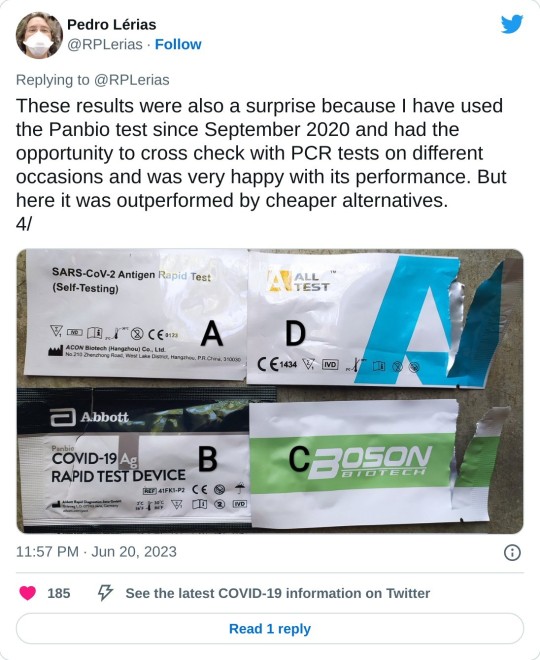

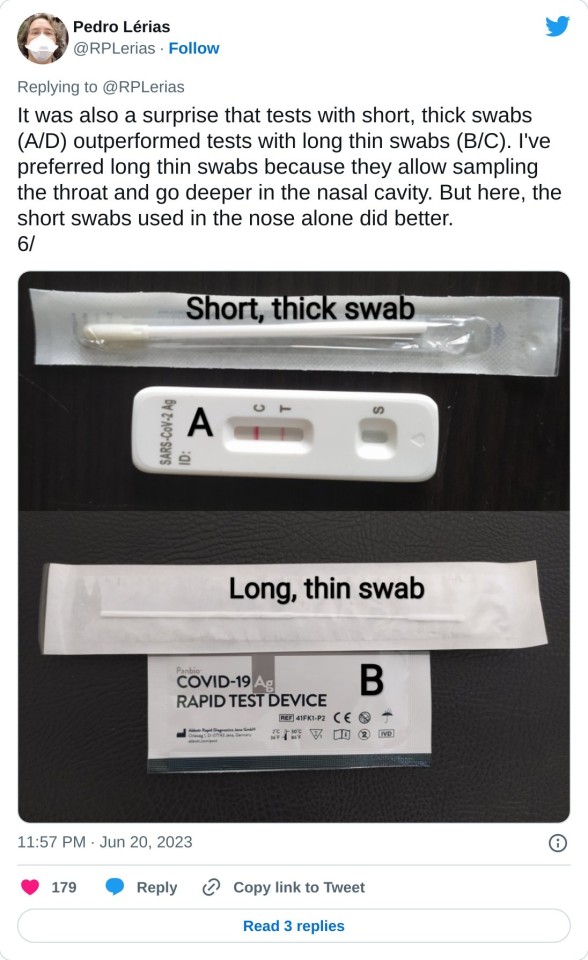

Another great post about tests and RATs. Trying different brands of tests, testing over a longer period, getting a PCR for medical records (and proof if attempting to apply for benefits and work accomodations) are all important.
Please know access to testing is a class and safety matter. Not everyone can afford to buy tests let alone several and for plenty of people getting tested in a medical setting to pharmacy is unsafe.
Advocate for funding for tests, outdoor tests and work with organizations and local libraries to secure donations so they can distribute them! Ignoring illness will not result in favorable outcomes or effective disease control, study, tracking and monitoring. Tests and screenings are conducive to and encourage better health, individually and collectively.
If I come across any posts about RATs in the U.S. and other countries I will add it to this post 💜
Update: Found one!
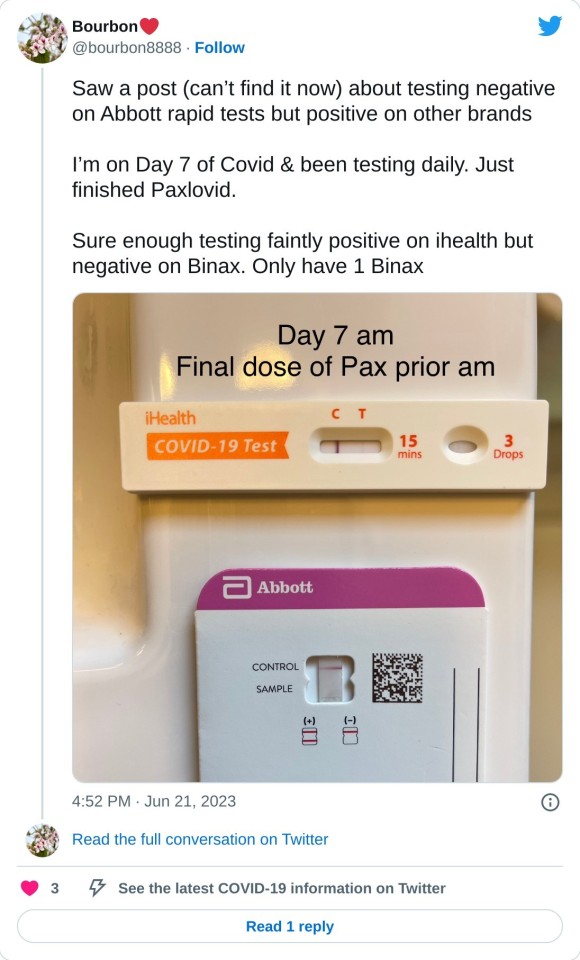
#Rapid Antigen Test#RAT#Covid testing#SARs CoV-2 testing#Screening#Public Health#The Pandemic#Pandemic
3 notes
·
View notes
Text
Happy Thanksgiving!


Good morning!
If you're going to see family or friends for Thanksgiving today & taking rapid tests before gathering:
Be sure to do a cheek, throat, and nasal swab correctly.
More info: #how to test
Rapid tests aren't fool-proof. (Explanation here.) But they can help when used properly. Increase certainty by:
Nasal-swabbing correctly. Here's a video showing how (on Twitter).
Also swabbing your cheek and throat. (More info, short.) Here's a good info sheet showing how, and a photo showing why (via EFD) ↓
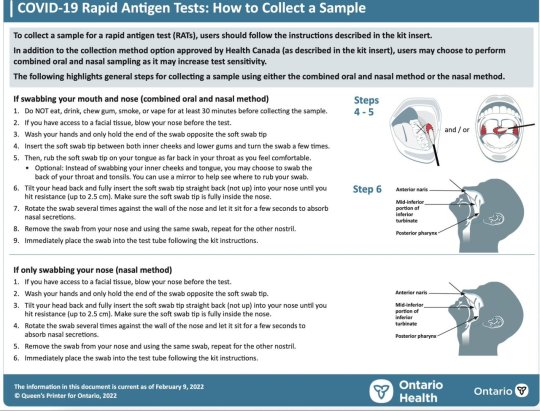
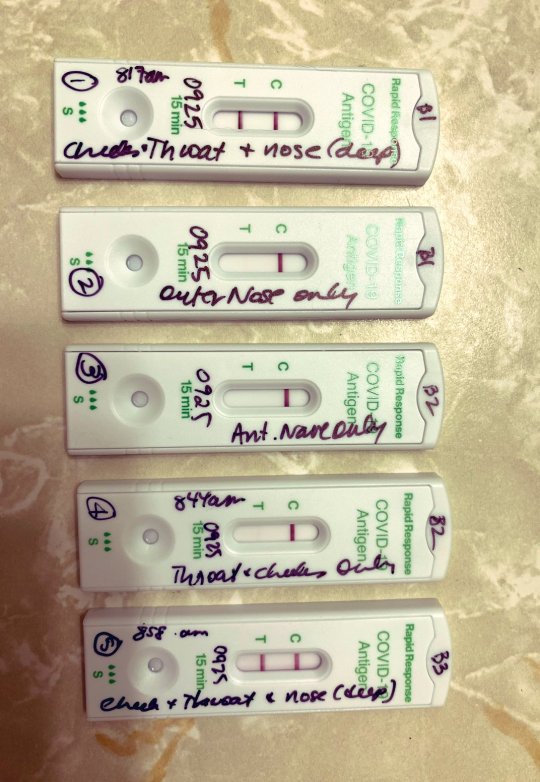
Thanks for taking care of those around you.
If you stumble on this post and don't know why you should test (after all, the US president et. al. say "it's over"),
Check the archive of this blog — links to research studies, data, and articles about the actual status of COVID in the US.
It's not over: beyond the short-term negative effects of acute COVID (among others: income loss, suicidal ideation, hospitalization, death),
Long COVID (lasting months beyond infection, sometimes forever) is affecting millions, is disabling, and there is no real treatment for it at this time.
See also:
SeeYouSafer.org
People's CDC
#how to test#holidays#transmission#rapid antigen test#RAT#rapid tests#rapid test#covid#avoiding covid#avoiding infection#avoiding long covid#covid is vascular#covid is not the flu#covid is airborne#covid is not mild#covid isn't over
4 notes
·
View notes
Text
3B BlackBio Biotech's Cutting-Edge Diagnostics for COVID-19 and Leukemia
In an era where precision diagnostics are paramount, 3B BlackBio Biotech India Ltd stands at the forefront of innovation, offering cutting-edge solutions for both infectious diseases and oncology. Among their notable products are the COVID Rapid Antigen Test and the PML RARA PCR Kit. These advanced diagnostic tools play critical roles in managing the COVID-19 pandemic and diagnosing acute promyelocytic leukemia (APL), respectively.
Quick and Precise: The COVID Rapid Antigen Test
The COVID Rapid Antigen Test by 3B BlackBio Biotech India Ltd is a crucial tool in the fight against COVID-19. Designed for rapid and reliable detection of the SARS-CoV-2 virus, this test provides results within minutes, facilitating timely decision-making in clinical and non-clinical settings.
Key Features and Benefits
Speed and Efficiency: The COVID Rapid Antigen Test delivers results in just 15-30 minutes, significantly reducing the waiting time compared to RT-PCR tests.
Ease of Use: The examination has been formulated with a focus on simplicity, necessitating only minimal training for healthcare professionals to conduct.
High Sensitivity and Specificity: The test accurately identifies active infections, helping to curb the spread of the virus by enabling quick isolation and treatment of positive cases.
Portability: The compact design of the test kit allows for easy transportation and use in various settings, including remote areas and community testing sites.
The availability of a rapid, reliable testing solution is essential for managing outbreaks and ensuring the safety of communities.
Advanced Oncology Diagnostics: PML RARA PCR Kit
In the realm of oncology, the PML RARA PCR Kit by 3B BlackBio Biotech India Ltd offers a sophisticated solution for the detection and quantification of the PML-RARA fusion gene, a hallmark of acute promyelocytic leukemia (APL). This kit is available in different formats, including the PML RARA Quantitative Kit and the PML RARA RT PCR Kit, each designed to meet specific diagnostic needs.
Importance of PML-RARA Detection
The PML-RARA fusion gene results from a chromosomal translocation and is a critical marker for diagnosing APL, a subtype of acute myeloid leukemia. Accurate detection and quantification of this fusion gene are essential for confirming the diagnosis, monitoring disease progression, and evaluating treatment response.
Key Features and Benefits
Precision and Accuracy: The PML RARA PCR Kit provides highly sensitive and specific detection of the PML-RARA fusion gene, ensuring accurate diagnosis.
Quantitative Analysis: The PML RARA Quantitative Kit allows for precise measurement of the fusion gene's expression levels, aiding in the assessment of disease burden and treatment efficacy.
Robust Protocols: The kits come with comprehensive protocols and high-quality reagents, ensuring reliable results and reproducibility across different laboratories.
Versatility: The PML RARA RT PCR Kit is designed for reverse transcription PCR, enabling the detection of RNA transcripts, which is crucial for understanding gene expression patterns.
By incorporating these advanced diagnostic tools into clinical practice, healthcare providers can improve patient outcomes through early detection and targeted therapy. For more information, visit PML RARA PCR Kit.
Conclusion
3B BlackBio Biotech India Ltd continues to lead the way in precision diagnostics with their innovative solutions for both infectious diseases and oncology. The COVID Rapid Antigen Test and PML RARA PCR Kit exemplify their commitment to enhancing healthcare through advanced technology and rigorous scientific research. Whether combating a global pandemic or diagnosing complex cancers, these products provide the accuracy, efficiency, and reliability that modern medicine demands.
Explore the full range of diagnostic solutions at 3B BlackBio Biotech India Ltd https://3bblackbio.com/.
0 notes
Text
What Crucial Factors to Check When Purchasing Rapid Antigen Test Kit Online?
Nowadays, when people are concerned about their health, the value of good rapid antigen test kits cannot be overstated. Reliable kits not only give correct outcomes but also give assurance during critical times. However, choosing the appropriate test kit requires considering a few things that will give you the perfect result.
Let’s delve into the three most important factors when buying an antigen test kit

Durability:
First and foremost, search for well-designed test kits that can last longer on the shelf. This is important because durable kits guarantee the components stay effective during their usage. In addition to this, make sure the kits are strong and sturdy enough to handle transportation, particularly if you are buying them in large quantities.
Quality:
The second most important thing to know is the quality of the rapid antigen test kit. Give importance to kits that follow regulatory rules and have been through a thorough examination and filtration process. Assurance of kit quality guarantees dependable outcomes, reducing the chances for both incorrect negative and positive results.
Time for Testing:
Rapid antigen tests are especially professions because they give results very fast. Look at the testing time stated by the maker; ideal kits should show results in between 15-30 minutes which permits people to make decisions without delay.
User-Friendliness:
Select kits that are simple to operate and have instructions which are easy to understand. Designs for users can help in the correct testing, reducing user mistakes and increasing result precision.
Where Can You Buy High-Quality Rapid Antigen Test Kits?
To sum up, if you are an individual or a healthcare professional looking for excellent rapid antigen test kits, it is crucial to consider factors such as durability, quality of the product, testing time and ease of use.
By selecting a trustworthy supplier like POC Diagnostics, you can be certain about getting the most dependable and accurate results. So, browse their website now and place your order for the perfect kit today.
1 note
·
View note
Text
On/Go COVID-19 Rapid Antigen Self-Tests
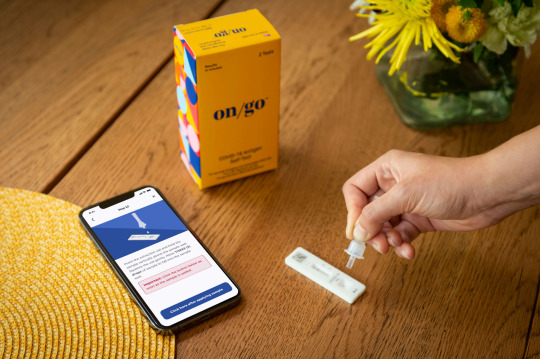
The On/Go™ COVID-19 Antigen Self-Test is an over-the-counter, self-administered rapid test that delivers results in just 10 minutes, with 95% accuracy.* On/Go is proudly manufactured in the United States.
This test is authorized for non-prescription home use for individuals with symptoms of COVID-19 within the first 7 days of symptom onset. The On/Go Self-Test is also suitable for individuals without symptoms or other epidemiological reasons to suspect a COVID-19 infection when tested twice over two or three days with at least 24 hours and no more than 48 hours between tests.
The On/Go 10-minute COVID-19 Antigen Self-Test is an over-the-counter (OTC) diagnostic tool designed to quickly and accurately detect the presence of SARS-CoV-2, the virus responsible for COVID-19.
Engineered for convenience and ease of use, this self-test provides reliable results in just 10 minutes, making it an ideal solution for individuals seeking quick and private testing at home. The On/Go test is designed for use by adults and children aged 2 years and older, with adult supervision recommended for children.
This self-test kit includes everything you need to perform the test: a nasal swab, test cassette, buffer solution, and detailed instructions. The On/Go test utilizes advanced immunoassay technology to deliver rapid and precise results, enabling timely decision-making regarding your health and safety.
95% accurate*
Rapid results at 10 minutes
Detects the antigen protein of all known major COVID-19 variants of concern (including Delta and Omicron)
Authorized for non-prescription self-use for individuals 14 years or older or adult-collected samples from individuals 2 years or older
For individuals with or without symptoms
Qualitative detection of SARS-CoV-2 nucleocapsid protein antigen via lower nasal swab samples
Only for use under the Emergency Use Authorization (EUA)
Single test for individuals with symptoms within 7 days of onset or two tests over two or three days for individuals without symptoms
For in vitro diagnostic use only
Specifications:
Test Type: Antigen self-test
Time to Results: 10 minutes
Sample Type: Nasal swab
Sensitivity: High (ability to correctly identify positive cases)
Specificity: High (ability to correctly identify negative cases)
Storage Conditions: Store at room temperature (15-30°C / 59-86°F)
Shelf Life: 12 months from the date of manufacture
Regulatory Status: FDA Emergency Use Authorization (EUA)
Shop Now: On/Go COVID-19 Antigen Self-Test
0 notes
Text
ANTIGEN TESTS IN 15 MINUTES: A REVOLUTION IN RAPID COVID-19 TESTING
0 notes